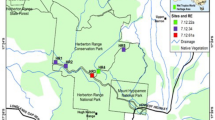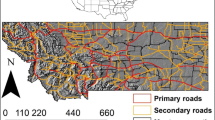Abstract
Road density and proportion of urban area are considered to be useful indicators of invasion risk from non-native plants. However, the mechanisms behind the relationship between these indicators and establishment of non-native species have rarely been addressed explicitly. To identify these mechanisms, we used a species distribution model (MaxEnt) for an invasive ornamental weed Rudbeckia laciniata using road density and proportion of urban area as explanatory variables, along with soil moisture and solar radiation. Overall model performance is relatively high (AUC = 0.91). Road density explained most R. laciniata occurrence, followed by the proportion of urban area. The occurrence probability of R. laciniata increased monotonically with road density, but the rates of increase constantly fell. The occurrence probability also increased with urban area when the proportion of urban area was small, but started to decrease when the proportion of urban area reached 0.2. Our results suggest that both road density and proportion of urban area are important factors in determining R. laciniata establishment but work differently.


Similar content being viewed by others
References
Akasaka M, Tsuyuzaki S (2005) Tree seedling performance in microhabitats along an elevational gradient on Mount Koma. Japan J Veg Sci 16:647–654
Akasaka M, Takada M, Kitagawa R, Igarashi H (2012) Invasive non-native species attributes and invasion extent: examining the importance of grain size. J Veg Sci 23:33–40
Austin M (2007) Species distribution models and ecological theory: a critical assessment and some possible new approaches. Ecol Model 200:1–19
Boršić I, Milović M, Dujmović I, Bogdanović S, Cigić P, Rešetnik I, Nikolić T, Mitić B (2008) Preliminary check-list of invasive alien plant species (IAS) in Croatia. Nat Croatia 17:55–71
Callaway RM, Aschehoug ET (2000) Invasive plants versus their new and old neighbors: a mechanism for exotic invasion. Science 290:521
Chytrý M, Jarošík V, Pyšek P, Hájek O, Knollová I, Tichý L, Danihelka J (2008) Separating habitat invasibility by alien plants from the actual level of invasion. Ecology 89:1541–1553
Collingham YC, Wadsworth RA, Huntley B, Hulme PE (2000) Predicting the spatial distribution of non-indigenous riparian weeds: issues of spatial scale and extent. J Appl Ecol 37:13–27
EPPO (2009) Priority list of invasive alien plants to be managed in EPPO member countries. EPPO Reporting Service
Foxcroft LC, Richardson DM, Wilson JRU (2008) Ornamental plants as invasive aliens: problems and solutions in Kruger National Park, South Africa. Environ Manag 41:32–51
Fu P, Rich PM (2000) The solar analyst 1.0 user manual. Helios Environ Model Inst
Gassó N, Sol D, Pino J, Dana ED, Lloret F, Sanz-Elorza M, Sobrino E, Vilà M (2009) Exploring species attributes and site characteristics to assess plant invasions in Spain. Divers Distrib 15:50–58
Gavier-Pizarro GI, Radeloff VC, Stewart SI, Huebner CD, Keuler NS (2010) Housing is positively associated with invasive exotic plant species richness in New England. USA Ecol Appl 20:1913–1925
Gelbard JL, Belnap J (2003) Roads as conduits for exotic plant invasions in a semiarid landscape. Conser Biol 17:420–432
Godefroid S, Koedam N (2003) Distribution pattern of the flora in a peri-urban forest: an effect of the city-forest ecotone. Landsc Urban Plan 65:169–185
Hernandez PA, Graham CH, Master LL, Albert DL (2006) The effect of sample size and species characteristics on performance of different species distribution modeling methods. Ecography 29:773–785
Hijmans RJ, Garrett KA, Huamán Z, Zhang DP, Schreuder M, Bonierbale M (2000) Assessing the geographic representativeness of genebank collections: the case of Bolivian wild potatoes. Conserv Biol 14:1755–1765
Holle BV, Simberloff D (2005) Ecological resistance to biological invasion overwhelmed by propagule pressure. Ecology 86:3212–3218
Kadoya T, Ishii HS, Kikuchi R, Suda S, Washitani I (2009) Using monitoring data gathered by volunteers to predict the potential distribution of the invasive alien bumblebee Bombus terrestris. Biol Conserv 142:1011–1017
Kanagawa plant research comittees (2001) Flora of Kanagawa 2001. Kanagawa Prefectural Museum of Natural History, Odawara
Kim DW, Jung CE, Jeon JB, Jeong JH (2007) Potential use of wild herbaceous plants as honey plants. Korean J Apic 22:9–32
Koike F, Clout MN, Kawamichi M, De Poorter M, Iwatsuki K (2006) Assessment and control of biological invasion risks. SHOUKADOH Book Sellers and the World Conservation Union (IUCN), Kyoto
Kolbek J, Sádlo J (1996) Some short-lived ruderal plant communities of non-trampled habitats in North Korea. Folia Geobot 31:207–217
Kondo T, Tsuyuzaki S (1999) Natural regeneration patterns of the introduced larch, Larix kaempferi (Pinaceae), on the volcano Mount Koma, northern Japan. Divers Distrib 5:223–233
Lockwood JL, Cassey P, Blackburn T (2005) The role of propagule pressure in explaining species invasions. Trends Ecol Evol 20:223–228
Mack RN, Lonsdale WM (2001) Humans as global plant dispersers: getting more than we bargained for. Bioscience 51:95–102
Margules C, Sarkar S (2007) Systematic conservationplanning. Cambridge University Press, Cambridge
Osawa T, Akasaka M (2007) Influence of aboveground removal on an invasive perennial herb Rudbeckia laciniata L. (Compositae) in June: difference in belowground size. Jpn J Conserv Ecol 12:151–155
Osawa T, Akasaka M (2009) Management of the invasive perennial herb Rudbeckia laciniata L. (Compositae) using rhizome removal. Jpn J Conserv Ecol 14:37–43
Osawa T, Inohara S (2008) Understanding current status and factors of degradation of threatened plants in the Hakone region of the Fuji-Hakone-Izu National Park: investigation using park volunteer research data. Jpn J Conserv Ecol 13:179–186
Parendes LA, Jones JA (2000) Role of light availability and dispersal in exotic plant invasion along roads and streams in the H. J. Andrews experimental forest, Oregon. Conserv Biol 14:64–75
Phillips S (2005) A brief tutorial on Maxent. AT&T Research
Phillips SJ, Dudik M (2008) Modeling of species distributions with Maxent: new extensions and a comprehensive evaluation. Ecography 31:161–175
Phillips SJ, Anderson RP, Schapire RE (2006) Maximum entropy modeling of species geographic distributions. Ecol Model 190:231–259
Richardson DM, Holmes PM, Esler KJ, Galatowitsch SM, Stromberg JC, Kirkman SP, Pyšek P, Hobbs RJ (2007) Riparian vegetation: degradation, alien plant invasions, and restoration prospects. Divers Distrib 13:126–139
Statistics Hakone (2014) Hakone town, Hakone. (in Japanese)
Sullivan JJ, Timmins SM, Williams PA (2005) Movement of exotic plants into coastal native forests from gardens in northern New Zealand. New Zeal J Ecol 29:1–10
Török K, Botta-Dukát Z, Dancza I, Németh I, Kiss J, Mihály B, Magyar D (2003) Invasion gateways and corridors in the Carpathian Basin: biological invasions in Hungary. Biol Invasions 5:349–356
Usda NRCS (2007) The PLANTS Database. National Plant Data Center, Baton Rouge
Venables WN, Ripley BD (2002) Modern applied statistics with S, 4th edn. Springer, New York
Von der Lippe M, Kowarik I (2007) Long-distance dispersal of plants by vehicles as a driver of plant invasions. Conserv Biol 21:986–996
Von der Lippe M, Kowarik I (2008) Do cities export biodiversity? Traffic as dispersal vector across urban–rural gradients. Divers Distrib 14:18–25
Walter J, Essl F, Englisch T, Kiehn M (2005) Neophytes in Austria: habitat preferences and ecological effects. Noebiota 5:13–26
Wichmann MC, Alexander MJ, Soons MB, Galsworthy S, Dunne L, Gould R, Fairfax C, Niggemann M, Hails RS, Bullock JM (2009) Human-mediated dispersal of seeds over long distances. P Roy Soc Lond B Biol 276:523–532
Wilson JP, Gallant JC (2000) Terrain analysis: principles and applications
Acknowledgments
We thank A. Tsujimoto and N. Kozuma for help conducting the field census and Joseph Bennett for his comments on the manuscript.
Conflict of interest
The authors declare that they have no conflict of interest.
Author information
Authors and Affiliations
Corresponding author
Additional information
Munemitsu Akasaka and Takeshi Osawa contributed equally to this work.
Rights and permissions
About this article
Cite this article
Akasaka, M., Osawa, T. & Ikegami, M. The role of roads and urban area in occurrence of an ornamental invasive weed: a case of Rudbeckia laciniata L. Urban Ecosyst 18, 1021–1030 (2015). https://doi.org/10.1007/s11252-015-0466-4
Published:
Issue Date:
DOI: https://doi.org/10.1007/s11252-015-0466-4




